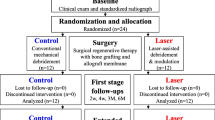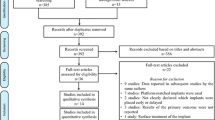Abstract
Objectives
The aim was to evaluate the rate of bone loss progression during experimentally induced peri-implantitis using two different implant-abutment connections in implants with identical surface topography.
Material and methods
Forty-eight Regular Neck tissue-level SLA implants with a matching implant to abutment connection (TL) and 36 bone-level SLA implants with a switching platform implant to abutment connection (BL) were subjected to experimental peri-implantitis in two independent in vivo pre-clinical investigations. Experimental peri-implantitis was induced by means of silk ligatures during 3 months (induction phase), and followed for one extra month without ligatures (progression phase). Radiographic and clinical outcomes were evaluated longitudinally along both studies and subsequently compared between experiments.
Results
During the induction phase, radiographic bone loss was significantly higher in implants with matched abutments compared with those with platform switching connections (2.65 ± 0.66 mm vs 0.84 ± 0.16 mm, respectively, p = 0.001). During the progression phase, both types of implant-abutment connection exhibited similar rates of radiographic bone loss. Similar outcomes were observed clinically.
Conclusions
A platform switching connection resulted in a more benign development of peri-implantitis during the experimental induction phase of the disease. These differences, however, disappeared once the ligatures were removed (progression phase).
Clinical relevance
Influence of the implant-abutment connection in peri-implantitis progression may be relevant when considering implant selection in the moment of placement. In this sense, platform switching abutment demonstrated less peri-implantitis development when compared to implant matching connection.





Similar content being viewed by others
References
Berglundh T, Armitage G, Araujo MG, Avila-Ortiz G, Blanco J, Camargo PM, Chen S, Cochran D, Derks J, Figuero E, Hammerle CHF, Heitz-Mayfield LJA, Huynh-Ba G, Iacono V, Koo KT, Lambert F, McCauley L, Quirynen M, Renvert S, Salvi GE, Schwarz F, Tarnow D, Tomasi C, Wang HL, Zitzmann N (2018) Peri-implant diseases and conditions: consensus report of workgroup 4 of the 2017 World Workshop on the Classification of Periodontal and Peri-Implant Diseases and Conditions. J Clin Periodontol 45(Suppl 20):S286–S291. https://doi.org/10.1111/jcpe.12957
Derks J, Tomasi C (2015) Peri-implant health and disease. A systematic review of current epidemiology. J Clin Periodontol 42(Suppl 16):S158–S171. https://doi.org/10.1111/jcpe.12334
Dreyer H, Grischke J, Tiede C, Eberhard J, Schweitzer A, Toikkanen SE, Glockner S, Krause G, Stiesch M (2018) Epidemiology and risk factors of peri-implantitis: a systematic review. J Periodontal Res 53(5):657–681. https://doi.org/10.1111/jre.12562
Berglundh T, Zitzmann NU, Donati M (2011) Are peri-implantitis lesions different from periodontitis lesions? J Clin Periodontol 38(Suppl 11):188–202. https://doi.org/10.1111/j.1600-051X.2010.01672.x
Lindhe J, Berglundh T, Ericsson I, Liljenberg B, Marinello C (1992) Experimental breakdown of peri-implant and periodontal tissues. A study in the beagle dog. Clin Oral Implants Res 3(1):9–16
Carcuac O, Abrahamsson I, Albouy JP, Linder E, Larsson L, Berglundh T (2013) Experimental periodontitis and peri-implantitis in dogs. Clin Oral Implants Res 24(4):363–371. https://doi.org/10.1111/clr.12067
Albouy JP, Abrahamsson I, Persson LG, Berglundh T (2011) Implant surface characteristics influence the outcome of treatment of peri-implantitis: an experimental study in dogs. J Clin Periodontol 38(1):58–64. https://doi.org/10.1111/j.1600-051X.2010.01631.x
Albouy JP, Abrahamsson I, Persson LG, Berglundh T (2008) Spontaneous progression of peri-implantitis at different types of implants. An experimental study in dogs. I: clinical and radiographic observations. Clin Oral Implants Res 19(10):997–1002. https://doi.org/10.1111/j.1600-0501.2008.01589.x
Schwarz F, Messias A, Sanz-Sanchez I, Carrillo de Albornoz A, Nicolau P, Taylor T, Beuer F, Schar A, Sader R, Guerra F, Sanz M (2019) Influence of implant neck and abutment characteristics on peri-implant tissue health and stability. Oral reconstruction foundation consensus report. Clin Oral Implants Res 30(6):588–593. https://doi.org/10.1111/clr.13439
Sanz-Sanchez I, Sanz-Martin I, Carrillo de Albornoz A, Figuero E, Sanz M (2018) Biological effect of the abutment material on the stability of peri-implant marginal bone levels: a systematic review and meta-analysis. Clin Oral Implants Res 29(Suppl 18):124–144. https://doi.org/10.1111/clr.13293
Cochran DL, Bosshardt DD, Grize L, Higginbottom FL, Jones AA, Jung RE, Wieland M, Dard M (2009) Bone response to loaded implants with non-matching implant-abutment diameters in the canine mandible. J Periodontol 80(4):609–617. https://doi.org/10.1902/jop.2009.080323
Strietzel FP, Neumann K, Hertel M (2015) Impact of platform switching on marginal peri-implant bone-level changes. A systematic review and meta-analysis. Clin Oral Implants Res 26(3):342–358. https://doi.org/10.1111/clr.12339
Sanz-Esporrin J, Blanco J, Sanz-Casado JV, Munoz F, Sanz M (2019) The adjunctive effect of rhBMP-2 on the regeneration of peri-implant bone defects after experimental peri-implantitis. Clin Oral Implants Res 30(12):1209–1219. https://doi.org/10.1111/clr.13534
Carral C, Munoz F, Permuy M, Linares A, Dard M, Blanco J (2016) Mechanical and chemical implant decontamination in surgical peri-implantitis treatment: preclinical “in vivo” study. J Clin Periodontol 43(8):694–701. https://doi.org/10.1111/jcpe.12566
Kilkenny C, Browne WJ, Cuthill IC, Emerson M, Altman DG (2010) Improving bioscience research reporting: the ARRIVE guidelines for reporting animal research. PLoS Biol 8(6):e1000412. https://doi.org/10.1371/journal.pbio.1000412
Mombelli A, van Oosten MA, Schurch E Jr, Land NP (1987) The microbiota associated with successful or failing osseointegrated titanium implants. Oral Microbiol Immunol 2(4):145–151. https://doi.org/10.1111/j.1399-302x.1987.tb00298.x
Schwarz F, Herten M, Sager M, Bieling K, Sculean A, Becker J (2007) Comparison of naturally occurring and ligature-induced peri-implantitis bone defects in humans and dogs. Clin Oral Implants Res 18(2):161–170. https://doi.org/10.1111/j.1600-0501.2006.01320.x
Carcuac O, Abrahamsson I, Derks J, Petzold M, Berglundh T (2020) Spontaneous progression of experimental peri-implantitis in augmented and pristine bone: a pre-clinical in vivo study. Clin Oral Implants Res 31(2):192–200. https://doi.org/10.1111/clr.13564
Becker J, Ferrari D, Herten M, Kirsch A, Schaer A, Schwarz F (2007) Influence of platform switching on crestal bone changes at non-submerged titanium implants: a histomorphometrical study in dogs. J Clin Periodontol 34(12):1089–1096. https://doi.org/10.1111/j.1600-051X.2007.01155.x
Becker J, Ferrari D, Mihatovic I, Sahm N, Schaer A, Schwarz F (2009) Stability of crestal bone level at platform-switched non-submerged titanium implants: a histomorphometrical study in dogs. J Clin Periodontol 36(6):532–539. https://doi.org/10.1111/j.1600-051X.2009.01413.x
Flores-Guillen J, Alvarez-Novoa C, Barbieri G, Martin C, Sanz M (2018) Five-year outcomes of a randomized clinical trial comparing bone-level implants with either submerged or transmucosal healing. J Clin Periodontol 45(1):125–135. https://doi.org/10.1111/jcpe.12832
Messias A, Rocha S, Wagner W, Wiltfang J, Moergel M, Behrens E, Nicolau P, Guerra F (2019) Peri-implant marginal bone loss reduction with platform-switching components: 5-year post-loading results of an equivalence randomized clinical trial. J Clin Periodontol 46(6):678–687. https://doi.org/10.1111/jcpe.13119
Souza AB, Alshihri A, Kammerer PW, Araujo MG, Gallucci GO (2018) Histological and micro-CT analysis of peri-implant soft and hard tissue healing on implants with different healing abutments configurations. Clin Oral Implants Res 29(10):1007–1015. https://doi.org/10.1111/clr.13367
Berglundh T, Gotfredsen K, Zitzmann NU, Lang NP, Lindhe J (2007) Spontaneous progression of ligature induced peri-implantitis at implants with different surface roughness: an experimental study in dogs. Clin Oral Implants Res 18(5):655–661. https://doi.org/10.1111/j.1600-0501.2007.01397.x
Roehling S, Gahlert M, Janner S, Meng B, Woelfler H, Cochran DL (2019) Ligature-induced peri-implant bone loss around loaded zirconia and titanium implants. Int J Oral Maxillofac Implants 34(2):357–365. https://doi.org/10.11607/jomi.7015
Acknowledgments
The authors would like to express their appreciation to personnel of the Rof Codina research facilities, Faculty of Veterinary, University of Santiago de Compostela, Lugo, for their invaluable support with the care of the animals and the histological preparation and measurements, specially to Maria Permuy.
Funding
The work was supported by the joint collaboration between Periodontology Department of University Complutense of Madrid as well as Periodontology Department of University of Santiago de Compostela, both in Spain. This study was self-funded by the ETEP Research Group, UCM-Madrid, and the Clinic of Periodontology of the School of Medicine and Dentistry, University of Santiago de Compostela, Spain and the Center of Biofunctional Studies, Complutense University, Madrid, Spain.
Author information
Authors and Affiliations
Contributions
• Javier Sanz-Esporrin: data retrieval, data analysis, helped in surgical procedures, and writing the manuscript.
• Cristina Carral: data retrieval, helped in surgical procedures, and editing the manuscript.
• Juan Blanco: surgeries in dogs, conceived the ideas, supervised the writing.
• Jose Sanz-Casado: surgeries in dogs, conceived the ideas, supervised the writing.
• Fernando Muñoz: histological preparation, histometrical measurements, critical histological analysis.
• Mariano Sanz: protocol design and manuscript writing and editing.
Corresponding author
Ethics declarations
Conflict of interest
The authors declare that they have no conflict of interest.
Ethical approval
All applicable international, national, and/or institutional guidelines for the care and use of animals were followed.
Informed consent
For this type of study, formal consent is not required.
Additional information
Publisher’s note
Springer Nature remains neutral with regard to jurisdictional claims in published maps and institutional affiliations.
Rights and permissions
About this article
Cite this article
Sanz-Esporrin, J., Carral, C., Blanco, J. et al. Differences in the progression of experimental peri-implantitis depending on the implant to abutment connection. Clin Oral Invest 25, 3577–3587 (2021). https://doi.org/10.1007/s00784-020-03680-z
Received:
Accepted:
Published:
Issue Date:
DOI: https://doi.org/10.1007/s00784-020-03680-z




